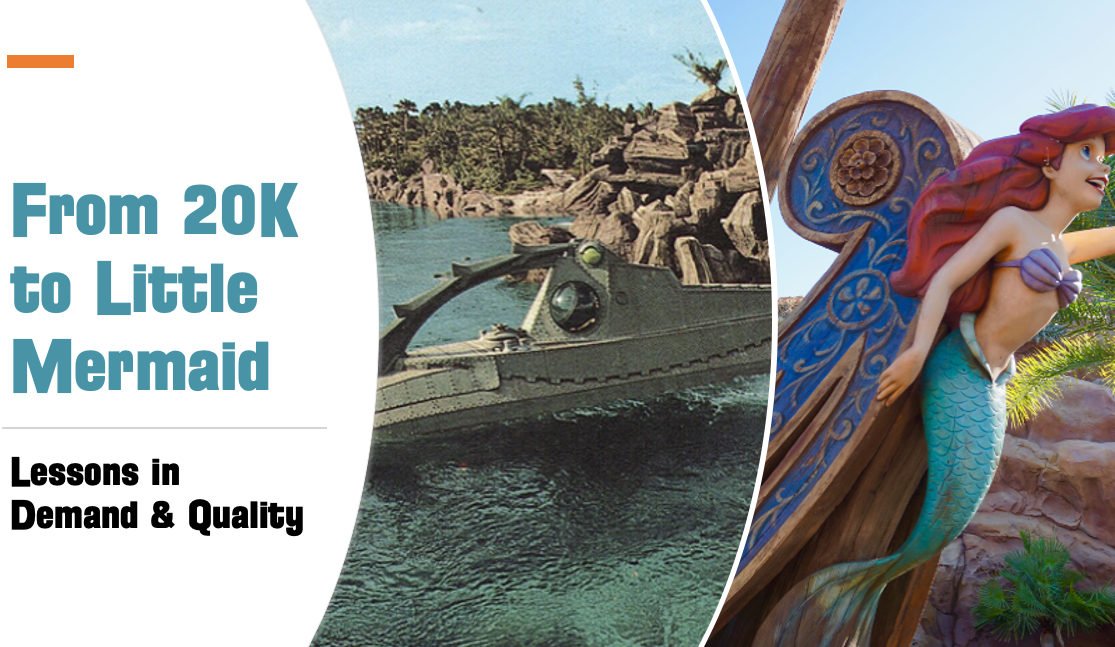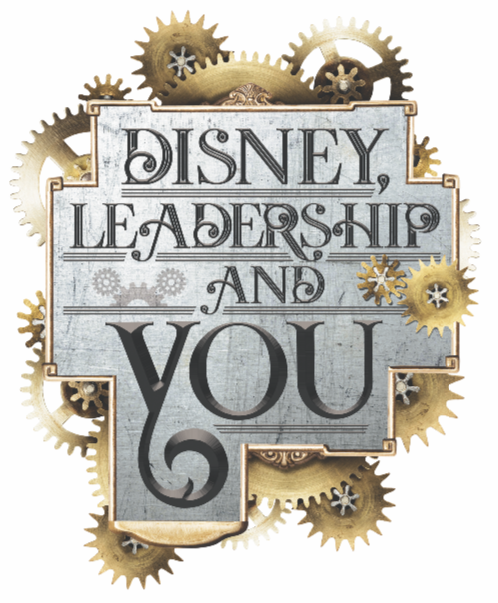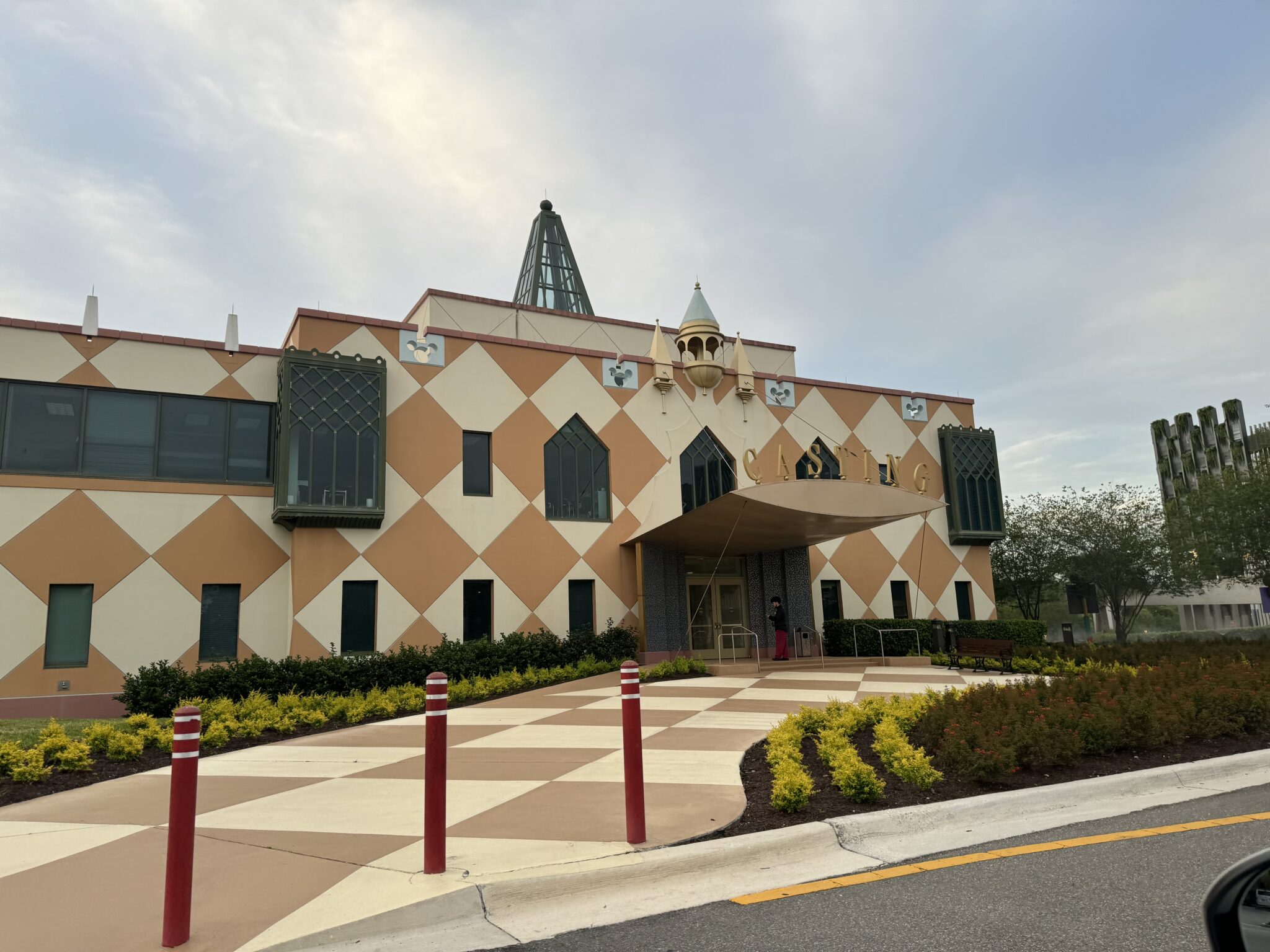From 20K to Little Mermaid

The Little Mermaid : Ariel’s Undersea Adventure is a dark ride attraction based on the 1989 Disney animated classic, The Little Mermaid. It sits in Fantasyland Forest in the Magic Kingdom. Guests are able to journey “under the sea” to experience the adventures of Ariel. But this isn’t the first time folks have been going under the sea in this corner of the park. We’re here to talk about the evolution of this ride and it’s roots in another legendary experience, 20,000 Leagues Under the Sea.
You can find our podcast here on Podbean, iTunes, Spotify, MyTuner, and ListenNotes. If you’re not familiar Fantasyland at the Magic Kingdom of Walt Disney World, please check out our overview.

Disneyland’s Submarine Voyage–A New Addition
To understand the roots of this attraction, one has to go back to this oft-quoted phrase from Walt Disney:

That quote was a response to a critic who noted that there were lots of pieces of Disneyland that hadn’t been 100% completed when it opened in 1955. But Walt had to walk the talk in a more major way when in 1958 C.V. Wood, Disneyland’s first head of operations, worked to open a place called Pacific Ocean Park in Santa Monica. Walt Disney had an exhibit of the Nautilus from 20,000 Leagues Under the Sea when he opened the park, but Wood created a Nautilus Submarine Exhibit based on a real submarine. It included a 150-foot model of the atomic reactor section. Then it also offered the Deepest Deep, a ride where passengers journeyed on a fake submarine ride with mermaids and other sea life.

Walt’s response was the first major capital addition to Disneyland. It was an expansion in 1959 when the Alweg Monorail, Matterhorn and Submarine Voyage. I offer another podcast (44) and post that talks about the advent of this attraction. It was wildly popular among guests who stood in long lines. That said, it was difficult to get passengers boarded and disembarked, and in truth, it was only a few inches under the sea. Still, Imagineers knew that they had to have something similar when the Magic Kingdom opened. Something even better.
Chapter 2: 20,000 Leagues Under the Sea–A Force Fit
Old timers seem to fondly remember the 20,000 Leagues Under the Sea attraction that originally was located here. Set against rock work and falls and a bright blue sea, these Nautilus subs were one of the most iconic offerings for anyone with a Kodak camera. You couldn’t help but want to take a picture or grab a postcard.

Like the Disneyland submarines, when the Magic Kingdom first opened in 1971, demand on this fairly slow boarding attraction was high. There was thought and even design effort put toward adding an additional dock and several subs to the 20K attraction. Bruce Laval, in his studies argued against it, saying that with the addition of Space Mountain, the demand for the “E Ticket” required to ride either attraction would go down as a new attraction was built nearby.

In an interview conducted by Duncan Dickson and Robert Ford of UCF, Bruce Laval shared that story about 20,000 Leagues Under the Sea.
Management argued that the queue for Pirates of the Caribbean had gone up when Haunted Mansion opened at Disneyland

Bruce noted that the reason the queues had increased was that an additional “E Ticket” had been added to the ticket books, and that with the greater number of “E-Tickets” there was more demand.

Bruce noted that the ticket book was not going to be changed at Magic Kingdom and thus the line would not become longer like it was there when Space Mountain opened.
The Lost Years–Doing Things Wrong
That’s what happened when Space Mountain opened. The size of the queue went down–for a while. When Epcot opened, ticket books went away, and the demand to go on 20K went back up. What guests didn’t understand was that the attraction had a very slow moving queue and one of the longest waits. Then Guests were disappointed that the attraction had no thrill component and was merely a moving aquarium displaying fake sea life.

The end result was higher disappointing guest feedback, not to mention raised eyebrows from guests with disabilities who had a very difficult time boarding and disembarking the attraction. From management’s viewpoint, it was very expensive to staff and operational keep up. It just wasn’t worth the cost to operate even though there was a demand.
Meanwhile, other demands came along, most notably, with the release of The Little Mermaid guests wanted an opportunity to interact with Ariel. Part of that demand was met at the Disney-MGM Studios when it created Voyage of the Little Mermaid.

Still, parents and kids thought something ought to be available at the Magic Kingdom. A play area and a meet and greet with Ariel was established. While the cost was reasonable compared to building a much larger attraction, it was still not what people really thought should be built–A Little Mermaid ride.

Imagineers have been asked many times: “Why hasn’t there been A Little Mermaid ride built?” The response has been that the technology was never quite right. What they meant to say was that they couldn’t find an affordable way to build an attraction that met the demand of being “under the sea” while still being reasonable about costs. It wasn’t like they weren’t trying. During the 90’s, as 20,000 League subs were being shelved at the Magic Kingdom, another set of subs was being built at Tokyo DisneySea.
Tokyo Disney Sea–Doing Things In a Bigger Way

This wasn’t just a submarine ride, this was a land that was entirely themed around Vulcania. While it had other Jules Verne attractions, it was largely based on 20,000 Leagues Under the Sea.
This attraction featured an “Under the Sea” experience in the form of 20,000 Leagues Under the Sea. Unfortunately, the attraction didn’t fake being under water that well, and the queue was still long for a set of ride vehicles that operated in the same way Peter Pan’s Flight works, a hanging suspension vehicle.

As the new millennium progressed it didn’t make it easier that Disneyland had taken its submarines and resurrected the attraction to be tied to Finding Nemo.
While costly to maintain, the new attraction has been very popular. Still, it wouldn’t work at the Magic Kingdom. Earlier, not seeing a solution on the horizon, imagineers removed the subs and filled in the hole that was 20K at the Magic Kingdom. In its place they created a playground tied to Winnie the Pooh. The attraction was affordable, but the demand was simply not there.

Finally, one solution came to mind. There had always been the thought of creating a dark ride based on the The Little Mermaid as part of the offering in Disneyland Paris. Cost overruns in Paris kept them from making that happen. Imagineers considered the possibility of creating a high end dark ride that would not only meet demand, but provide for greater capacity than the submarines or any other attraction built heretofore could provide.

Moreover, Imagineers reasoned building not one, but two Little Mermaid attractions would help reduce development costs. So an additional Little Mermaid attraction was created at Disney California Adventure at Disneyland to combat the under-utilization of that park.

So now with The Little Mermaid attraction, ride vehicles are able to accommodate many guests per hour, including those with mobility challenges. The dual creation of the attraction here and at Disney California Adventure allows costs to be lowered. In the end, the park is able to increase capacity and meet demand while maintaining costs.

Souvenirs for Your Organization
Consider the following when thinking about you and your organization:
- How do we balance the quality and quantity of the products and services demanded with cost?
- How do we measure the demand for the products and services we offer?
- How can we “re-imagineer” our products and services to better meet demand while still respecting cost?
Disney, Leadership and You
There’s more insights like this, not just from one leader, but from nearly 100 leaders that have defined the Walt Disney Company over the years. From Walt Disney, to imagineers, to animators and performers, the company’s success has been made real by the labor and leadership of not just a CEO, but of so many. Learn those lessons of leadership when you read.






